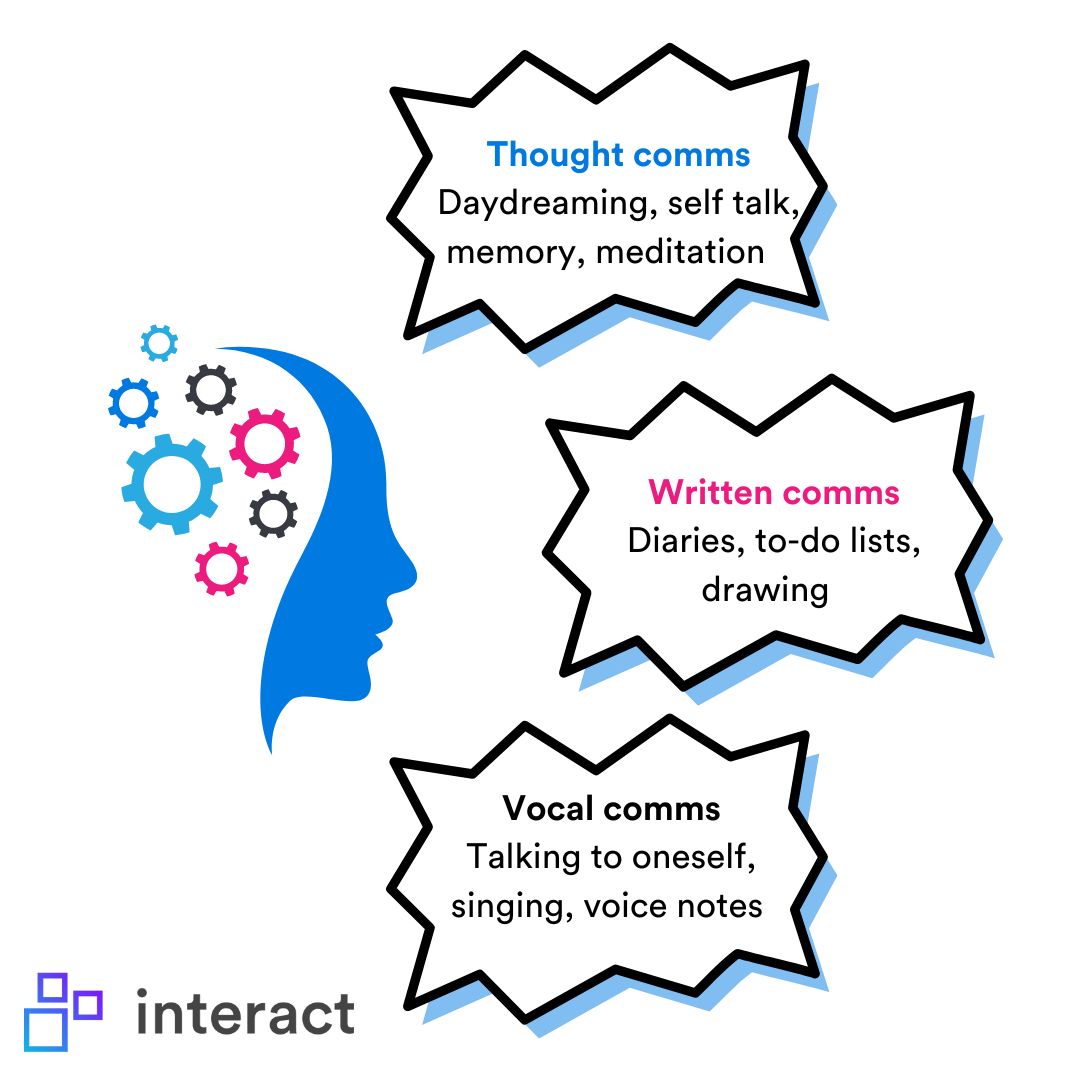Intrapersonal communication is the positive comms practice that reduces stress and helps us perform better at work. It’s time to include it in our comms strategies.
How many types of communication happen in your organization each day?
There are the chance conversations at the watercooler (and their virtual equivalents). There are Teams messages and company-wide intranet announcements. And it doesn’t stop there. We think there are at least eight forms of knowledge sharing and feedback to include in an internal communication strategy.
Intrapersonal communication is the ninth type of comms, and the one that’s least well understood.
Here’s the lowdown on the definition and examples of intrapersonal communication, along with how organizations and communicators can include it in their comms strategies.
What is intrapersonal communication?
Intrapersonal communication is a way of communicating with yourself. The most common example is the “inner voice” that people employ to mentally describe or process events. But intrapersonal communication is not just about talking to yourself silently. It includes reflecting on experiences and remembering events in order to understand them better.
Discover the 14 steps to effective internal communications
Some examples of intrapersonal communication are when you talk to yourself, daydream, reflect on your thoughts and feelings by writing in a journal, imagining things in your mind, or practicing meditation.
Using these communication techniques in a positive way can help you and your colleagues work better and reduce stress in your personal life.
Why (most) people have an inner voice
At a basic level, your inner voice can help you remember information. For example, you may learn new facts or passwords by repeating them several times in your mind.
On the other end, some people have a highly developed and fluent inner voice that allows them to rehearse or imagine conversations and presentations in great detail.
Where does it come from?
Psychologists think that inner discourse develops when we are young and becomes an important part of how we control our actions and thoughts.
Children learn about the world through language given to them by parents, teachers, and other caretakers – “Eat your greens, they’re good for you”. As a result, children often process their experiences through a narrator’s voice. This may include speaking to themselves as if the instruction, praise, or discipline came from them. “I am good because I ate my greens!”
As we grow, the complex mind internalizes more information, but the essential directing voice remains the same, even when we enter the workplace.
At work, what we tell ourselves about ourselves is a powerful element informing how we feel about a situation. If you approach a work presentation convinced you are a terrible presenter, a subpar performance will probably follow. Go in with confidence and your audience will have a different experience. And it all begins with intrapersonal communication.
Every person’s inner voice is different
Crucially, the definition of intrapersonal communication differs for every person, and it can be either positive or negative. While some people live with a debilitating inner monologue that questions everything they do (approximately 70% of people suffer from imposter syndrome at some point), others simply don’t entertain the same stream of thoughts.
Discover the 14 steps to effective internal communications
So, what kind of intrapersonal communications do you exhibit and can you change them (and educate your colleagues on changing theirs) so that everyone in your organization has healthier self-driven comms?
Three examples of intrapersonal communication you may recognize
What happened during your last interaction with someone at work?
It may seem simple, but how you remember that experience indicates the specific way you communicate intrapersonally. You may have narrated it for yourself in the third-person, or perhaps you remembered fragments of sounds. Maybe you thought of the visual elements, grabbed a pen and started doodling.
If you recognize any of the examples below, you’re already engaged in the process of speaking with yourself. The next stage, as with any form of communication, is to make it as productive as possible.
- Thought – The term “inner monologue” can be reductive for people who do not carry on a running narrative in their own minds. Performing self-reflection, meditation, daydreaming, and remembering sounds or images are all forms of intrapersonal communication that can help you process experiences. It doesn’t have to be the equivalent of a novel.
- Graphical – We don’t only write or create graphical notes for other people. Keeping a diary, online journaling, writing lists, drawing, or even just keeping post-it notes are all self-directed forms of communication.
- Vocal – Singing in the shower may seem an odd self-improvement tool but many of us narrate our lives through song. Some people also practice presentations out loud, rehearse conversations, and repeat new information until they remember them. Vocalizing information can be a powerful way to understand it better.
Because these things are personal, they are infrequently discussed with others. And they certainly aren’t included in an internal communications plan.

They can all be practiced and improved though, with benefits for all.
Strategies to improve your intrapersonal skills
Depending on the individual, intrapersonal communications can either be helpful or harmful.
Speaking to yourself as a way of logically working through and solving problems, for example, can be a highly effective strategy.
On the other hand, if you get trapped in what psychologist Dr Ethan Kross calls a “cyclical, verbal, negative dynamic,” i.e., continually asking “What if this bad thing happens?” then your way of communicating with yourself may induce anxiety, and block personal (and professional) development.
Kross, a leading expert on controlling the conscious mind and a professor in the Psychology Department at the University of Michigan, says that when we constantly think about negative things, it activates our fight or flight response and keeps it active, which is not good for us. It can limit our ability to think and reason clearly.
To avoid this, we should focus on developing positive intrapersonal communication, which can help us achieve better outcomes and avoid negative thought cycles.
Discover the 14 steps to effective internal communications
Here are three ways to positively improve intrapersonal communication.
1. Practice positive thinking
Breaking the habit of negative thinking and catastrophizing can be challenging, but daily practice can help change your thought patterns and improve your relationship with your inner speech.
The first step is to recognize when you’re spiraling into negative thoughts and take a breather. For example, if you hear that the company is getting a new CEO and start worrying about losing your job, or if you’re asked to do a presentation and feel inadequate, pause and practice positive affirmations.
Try flipping negative thoughts into positive ones, then repeat them until they make more sense. Instead of thinking that the boss is demanding information you don’t have, say that your boss wants you to succeed and that this is an opportunity to show how resourceful you are.
2. Write your thoughts down
Writing therapy differs from journaling because it uses writing, drawing, and mind maps in response to prompts or exercises. Writing is guided towards helping you reflect on certain topics and recurring issues rather than simply recording.
The process also involves recording how you thought and felt about a situation. This may include writing down how you physically felt and what thoughts went through your mind.
Simple techniques include:
- Use an easily accessible format (phone notes are valid too).
- Setting a target for how long you want to write each day. Giving yourself a word count may make it feel like a chore, so a time limit can encourage adherence.
- Deciding on the logistics of when and where you’ll write. Similar to daily meditation or exercise, it’s important to find a physical state to match mental activity.
- Finding relevant writing prompts. If work is your focus, why not include work-based prompts first. You might spend five minutes on “At work today, ….” and then have a second five-minute section on how it made you feel and act.
- Summarizing what you’ve written in a couple of sentences can make it easier to scan through the previous week or month and look for patterns. Identify anything regularly causing happiness or anxiety and act accordingly.
Can writing work to improve intrapersonal communication? The research says yes.
“For individuals who have experienced a traumatic or extremely stressful event, expressive writing guided purposefully toward specific topics can have a significant healing effect. In fact, participants in a study who wrote about their most traumatic experiences for 15 minutes, four days in a row, experienced better health outcomes up to four months than those who were instructed to write about neutral topics (Baikie & Wilhelm, 2005).”
3. Saying your own name can aid self-reflection
You live with yourself more than anyone else, so it’s normal to vocalize thoughts and talk to yourself.
Consider how you would advise someone else if you were speaking to them rather than yourself. Are their fears groundless? Have you identified an opportunity for personal growth that this other person may have missed?
Self-vocalization can help to:
- See opportunities clearly – “You’ve been asked to take on a new piece of work, but that doesn’t mean you have to do everything all at once. Ask your manager for advice on what can be put on the back burner and then you’ll be able to do this new work, which could be really productive.”
- Stop catastrophizing – “Stop. You have raced ahead to a lot of unrealistic possibilities and it’s better to just deal with what is in front of you. Now, what’s the first step?”
- Identify new ways of doing things – “That was an interesting project, was there anything you would have done differently? Write them down in a few bullet points and share them with your colleagues. They probably have other ways of improving our processes too.”
- Stop making yourself the center of everything – “Do you think that client really didn’t like you or are you making this situation about yourself? Perhaps something personal is going on in their life that is causing them anxiety. Maybe it’s time to give yourself a break, you’re not responsible for how other people feel.”
- Encourage objectivity about emotions – “Your heart is racing and you feel angry. This is a totally natural fight-or-flight reaction. It will pass.”
- Self-motivate – “Come on, you’ve prepared well for this presentation and it’s going to be successful, look at all the work you’ve put in already!”
Can these processes help?
If you’re wondering about the efficacy of this, science suggests that speaking aloud actually changes your mental processing.
In one experiment, saying the names of a series of objects aloud (rather than just thinking about them) changed how effective participants became in visually identifying them. Saying the word aloud helped the brain to find the answer.
And there’s another secret trick to know. As part of a process called “distanced self-talk,” you should use your own name and more objective pronouns when speaking with yourself. Saying your own name at the beginning of a sentence can help the brain to gain greater objectivity.
Discover the 14 steps to effective internal communications
Dr Ethan Kross says:
“If you use your name to think about yourself, it’s almost like a psychological jujitsu move. It changes your perspective on your problems. It’s getting you to think about your problems from a more objective standpoint, like they’re happening to another person.”
Help others in your workplace to develop good habits
So far, so self-directed. Intrapersonal communication can become part of your internal comms strategy, however, and it can benefit your workmates too.
Using the examples of intrapersonal communication above, it’s easy to create a dedicated area on your intranet that hosts all the strategies people need to develop their own intrapersonal skills.
A CMS intranet enables you to create an internal knowledge base of dedicated pages containing engaging rich-media content.

Examples of intrapersonal communication content may include:
- Guided prompts
- Educational videos
- Design elements that break up text into FAQs
- Downloadable PDF mindfulness journals
- Playlists of relaxing music
- Images and diagrams

As with any internal comms campaign, driving traffic to your newly created resources (and then periodically reminding people) can be achieved through a schedule of multichannel communications. Sending notifications through email, mobile app, digital signage, and more, can all help to alert your key audiences that resources are available.
If you want to generate conversation and support, having enterprise social network tools such as liking and @mentioning can also encourage people to share their own experiences. Why not ask influential people within the organization to post a blog or vlog and drive greater awareness.
Inviting a professional speaker to give a “lunch and learn” session can also be a good launch activity. If the session is recorded (or hosted virtually) then you can post the video in the new content area too.
It is possible to change your mind
70% of people experience imposter syndrome.
It’s a self-generated issue that often arises when a negative inner voice suggests you’re not good enough and won’t be able to thrive in certain situations.
There’s no single, simple answer to reduce this for everyone, but the research suggests that you can develop better intrapersonal skills through practice.
Sharing the same practices within your workplace may help even more people to have greater ego strength and a healthier mindset.



